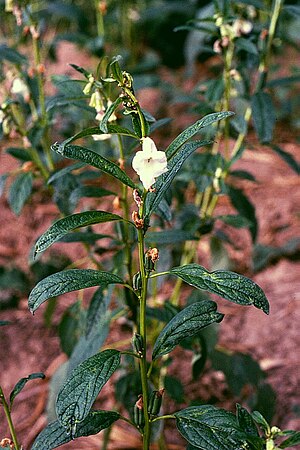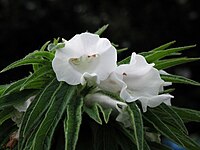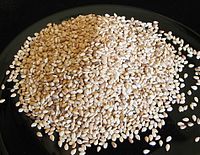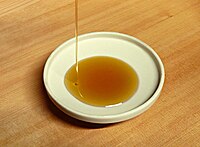Sesamum indicum
Read community contributed articles on biodiversity & environment || Cultural practices & mythological stories related to Indian biodiversity || Official documents related to environment || NGOs, Blogs and Websites || Environment-related video collection || Plants of India || Mammals of India || Facebook || Twitter
Share this page: Sesamum indicum
Click here to see all Semantic Properties associated with this page
Please note that the above slideshow is automatically created by searching Flickr and does not contain manually curated images. Hence, it is likely that some images may not be exactly of Sesamum indicum.
Click on the tabs below to know more...
- Species identity and nomenclature
- Current Wikipedia entry
- Binomial Classification
- Morphological features
- Habitat and Geographical Spread
- Maps
- Medicinal Importance
- Cultural significance
- Commercial importance and cultivation
- Summary of PubMed articles
- Summary of NCBI molecular data
- External Links
- Images and Videos
| Parameter | Value(s) | References See complete references in the References section at the end |
|---|---|---|
| Names of users who have contributed to this species page | Supriyak, shwetankverma | |
| Date on which this page was first created | 2010/10/30 | |
| This page was last modified on: | 6 December 2010 13:27:06 | |
| Name of the species | Sesamum indicum | |
| ID on Encyclopedia of Life | 484896 | |
| Synonyms | Please check Binomial Classification section for synonyms. | |
| Common English Names | Sesame | |
| Common Hindi Names | Gingli, Til | |
| Common Indian names | Juljulan,Simsim,Sumsum,Zelzlane (Arabic) ; Tisi (Assamese) ; Til (Bengali) (Urdu) ; Mittho-tel,Tal (Gujrathi) ; Ellu,Tila (Kannada) ; Chitelu, Ellu (Malayalam) ; Bariktil,Ashadital,Til (Marathi), Ellu (Tamil) ; Nuvvulu, Tillu (Telugu) ; | EOL |
| Origins/Meanings of the common names |
Taxonomy from Encyclopedia of Life
If nothing is displayed in this section, it means the EoL ID has not been defined. Please click on Edit with form button on top and follow the instructions for filling in the EoL ID
{{#EoLOnlyHierarchy:484896}}
Taxonomy filled in form
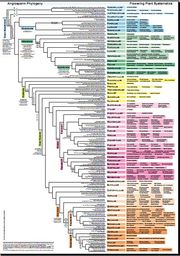
Click here for the PDF of the phylogeny
| Taxon | Value |
|---|---|
| Regnum (Kingdom) | Plantae |
| Division | Magnoliophyta |
| Class | Magnoliopsida |
| Order | Scrophulariales |
| Family | Pedaliaceae |
| Genus | Sesamum |
| Source of data | EOL |
| ||||||||||||||||||||
| Division | Taxon details | Taxon morphology details |
|---|---|---|
| Magnoliophyta | Also called Angiospermae. The ancestors of flowering plants diverged from gymnosperms around 245–202 million years ago, and the first flowering plants known to exist are from 140 million years ago. They diversified enormously during the Lower Cretaceous and became widespread around 100 million years ago, but replaced conifers as the dominant trees only around 60-100 million years ago. | These are seed plants like Gymnosperms, but can be differentiated by the presence of flowers, seeds containing endosperm and seeds that produce a fruit. Angiosperms are the most diverse and highly evolutionarily successful group of land plants. |
| ||||||||||||||||||||
| Class | Taxon details | Taxon morphology details |
|---|---|---|
| Magnoliopsida | Magnoliopsida is the scientific name for dicots. This class contains about ~1,99,350 species of Angiosperms. Eudicots are a subset of Dicots. Based on chloroplast DNA sequences, the divergence date between monocots and dicots is estimated to be ~200 million years, with a 40 million years uncertainty. | Dicots are diverse in habit, with half of all the species being more or less woody-stemmed - a reflection of the usual presence of a vascular cambium in the class. Annuals, biennials, vines, epiphytes, aquatics, parasites, and saprotrophs are also well represented in dicots. Vascular bundles of the stem are usually borne in a ring that encloses the pith. Vessel elements present except in some putatively primitive woody or aquatic families. Most dicots have a primary root system derived from the radicle, although some have an adventitious root system commonly seen in the class of monocots. Cotyledons are usually 2, seldom 1, 3, or 4. Leaves are mostly net-veined. |
| ||||||||||||||||||||
| Order | Taxon details | Taxon morphology details |
|---|---|---|
| Lamiales | Species in this order probably arose ~70-100 million years ago based on various estimates. Lamiales contain ~12% of eudicot diversity. Well-known or economically important members of this order include lavender, lilac, olive, jasmine, the ash tree, teak, snapdragon, sesame, psyllium, and a number of table herbs such as mint, basil, and rosemary. | Members of this species are herbaceous or shrubby, have mono-symmetric flowers and numerous small seeds. Species in this order typically have the following characteristics, although there are exceptions to all of them - 1) superior ovary composed of two fused carpels 2) five petals fused into a tube 3) bilaterally symmetrical, often bilabiate corollas and 4) four (or fewer) fertile stamens |
|
|
Based on classification
More details can be found in the Binomial Classification section.
Morphology from Encyclopedia of Life
If nothing is displayed in this section, it means the EoL ID has not been defined. Please click on Edit with form button on top and follow the instructions for filling in the EoL ID
{{#EoLOnlyDescription:484896}}
General morphology
| Parameter | Value(s) | References See complete references in the References section at the end |
|---|---|---|
| General morphological features of the plant | Sesamum is an erect and annual herb. The plant is simple or branched. Stems of early cultivors are unbranched, late maturing cultivors show pronounced branching, stems square, longitudinally furrowed, green, occasionally purple. The leaves are opposite below and alternate above. Leaves at the top are lanceolate where as the leaves below are ovate, toothed or lobed with varying shapes. Leaves hairy on both sides, margins ciliate, exstipulate, ovate, sometimes palmately lobed or palmately compound; petiole about 5 cm long, lamina 8-15 x 6-10 cm, coarsely serrate. Upper leaves alternate or sub-opposite, lanceolate, entire or with 1-few coarse teeth, petiole 1-2 cm long; lamina 5-13 x 1-3 cm. The flowers are borne in the leaf axils in two’s or three’s and often solitary and are variously coloured starting from pure white to purple or to deep violet ."Sesamum is an erect and annual herb. The plant is simple or branched. Stems of early cultivors are unbranched, late maturing cultivors show pronounced branching, stems square, longitudinally furrowed, green, occasionally purple. The leaves are opposite below and alternate above. Leaves at the top are lanceolate where as the leaves below are ovate, toothed or lobed with varying shapes. Leaves hairy on both sides, margins ciliate, exstipulate, ovate, sometimes palmately lobed or palmately compound; petiole about 5 cm long, lamina 8-15 x 6-10 cm, coarsely serrate. Upper leaves alternate or sub-opposite, lanceolate, entire or with 1-few coarse teeth, petiole 1-2 cm long; lamina 5-13 x 1-3 cm. The flowers are borne in the leaf axils in two’s or three’s and often solitary and are variously coloured starting from pure white to purple or to deep violet ." cannot be used as a page name in this wiki. | Sasya Sampada |
| Seed dispersal mechanism | ||
|---|---|---|
| Bloom type | Perennial | |
| Life cycle of the plant |
How to identify this species
For a detailed description, refer to the General Morphology details above
| Parameter | Value(s) | References See complete references in the References section at the end |
|---|---|---|
| Type of plant | Herb | |
| Plant height | ||
| Flower color | White | Wikipedia |
| Flower shape | ||
| Floral symmetry | Bilateral | |
| Phyllotaxy of leaves | ||
| Leaf shape | ||
| Is the leaf petiolated or sessile? | ||
| Is the leaf simple or compound? |
| Parameter | Value(s) | References See complete references in the References section at the end |
|---|---|---|
| IUCN Conservation Status | Not Evaluated | EOL |
| Indian States in which the species has been documented | Assam,Andhra Pradesh,Bihar,Delhi,Goa,Gujarat,Jammu and Kashmir,Karnataka,Madhya Pradesh,Maharashtra,Orissa,Rajasthan,Tamil Nadu,Uttar Pradesh | Plant Database of India,shwetankverma |
| Locations at which the species has been documented | Kurnool;Lakhimpur;Daman;nagerhaveli;Jammu;Bangalore;Mysore;Bhopal;Bilaspur;Jabalpur;Amravati;Pune;Madras;Agra;Gorakhpur | Plant Database of India |
| Biotic zones inhabited | ||
| Details about the habitat | ||
| Is this species native to India? | Yes | FOI |
| Is the species indigenous/endemic to Sub-Himalayan regions? | ||
| Is the species indigenous/endemic to Western Ghats? | ||
| Is the species indigenous/endemic to Eastern Ghats? |
More plants native to India
| ||||||||||||||||||||||||||||||||||||||||||
If no maps are displayed below, it means the required data is absent. Click on "Edit with form" button on top of the page to add this information.
{{#generateMap:Assam,Andhra Pradesh,Bihar,Delhi,Goa,Gujarat,Jammu and Kashmir,Karnataka,Madhya Pradesh,Maharashtra,Orissa,Rajasthan,Tamil Nadu,Uttar Pradesh|Sesamum_indicum_brahma.svg|align=center}}
| Parameter | Value(s) | References See complete references in the References section at the end |
|---|---|---|
| Does this species have any medicinal use? | Yes |
|
Other plants of the same family having medicinal use:
|
| Parameter | Value(s) | References See complete references in the References section at the end |
|---|---|---|
| General types of ailments this species is used for treating | Infectious diseases, Pains and Inflammation, Systemic disorders | |
| Specific ailments for which the species is used | antibacterial agent in mouthwash, sedative, anxiety and insomnia, high blood pressure, Vitamin deficiency, antifungal activity, hypolipidaemic, Hypoglycemic effects | Journal of Herbal Medicine and Toxicology |
| Medicinal systems which use this plant | Ayurveda, Folk Medicine | shwetankverma |
| Details of Medicinal use | Traditional Indian massage oil, dry flowers are used in for treating alopecia, frostbite and constipation, treatment of verruca vulgaris (Common Wart) and verruca plana (clusters of warts, which are usually found on the soles of the foot, and around the toes), cholesterol-lowering effect has been reported humans | |
| Parts of the plant used for treatment | Flower, Seeds, Other | shwetankverma |
| Names of some medicinal active compounds in this plant, if known. | sesamin, sesamolin, sesamol and sesaminol(phenolic antioxidants), chlorosesamone (2-chloro- 5, 8-dihydroxy-3-3methyl-2-butenyl)-1, 4- naphthoquinone), sesamolinol
diglucoside, Anthrasesamones A, B and C |
Journal of Herbal Medicine and Toxicology |
| Details of the active chemical compounds found in this plant | ||
| Is the molecular basis of the medicinal action known? | Yes | |
| Details of molecular basis of action | >sesamol and sesaminol -- (phenolic antioxidants),
>chlorosesamone (2-chloro- 5, 8-dihydroxy-3-3methyl-2-butenyl)-1, 4- naphthoquinone) -- (chlorinated red naphthoquinone pigment with antifungal activity) |
Journal of Herbal Medicine and Toxicology |
| Are the toxic effects of consumption of this plant known? | ||
| Details of the toxic effects of the plant species | ||
| Have there been validation/clinical studies related to this plant? | Yes | |
| Details of the clinical studies related to the plant species |
| Parameter | Value(s) | References See complete references in the References section at the end |
|---|---|---|
| Is this plant/plant-derived product used in food preparations? | Yes | User-reported |
| Part(s) of the plant used in the food preparations | Seeds | |
| Details of use in food preparations | Used in many parts of Indian Subcontinent as cooking oil. | |
| Does this species have any religious significance? | Yes | User-reported |
| Religions which mention/give significance to this species | Hinduism | |
| Religious occasions | ||
| Details of religious use |
| Parameter | Value(s) | References See complete references in the References section at the end |
|---|---|---|
| Is this plant cultivated commercially in India? | Yes | |
| Uses for which the plant is commercially cultivated | Human consumption, Medicinal use, Cosmetic use, Religious use, Industrial use | |
| Plant parts of commercial value | Root, Leaves, Flower, Seeds | shwetankverma |
| Products where this plant is used | User-reported | |
| Description of use | ||
| States where this plant is cultivated commercially | Bihar, Punjab | shwetankverma |
| Best period for planting this plant | ||
| Best period for harvesting this plant | ||
| Method of propagation | ||
| Water requirement of this plant | ||
| Pests and Diseases affecting this plant during cultivation | Sesame is used as a food plant by the larvae of some Lepidoptera species, including the Turnip Moth. | Wikipedia |
| Other considerations while cultivating this plant |
Pubmed Word cloud
This word cloud is obtained using the tool LigerCat by searching the Pubmed database. LigerCat builds the cloud from the most relevant Medical Subject Headings (MeSH) terms. Each term's relative size indicates how many times it appears in the PubMed search results. Click on a term to access the full LigerCat cloud, with live PubMed search capabilities. LigerCat has been developed for the Biology of Aging Project.
The page may take some time to load since LigerCat is searching the entire PubMed database and sending us the results in real time.
- If there is an error message below, it means that there is no retrievable information available on NCBI
- If the number of nucleotide sequences is less than 100, very little genomic work has been done on this species. A respectable number of nucleotide sequences is above 10000.
- Most of the nucleotide sequences may come from three sources:
- Studies on single genes, where people try to sequence genes such as some specific dehydrogenases important,say, for tannin production
- Sequences of Ribosomal Internal Transcribed Spacer, whose sequence is used for generating molecular phylogenetic trees to establish species relationships
- Expressed Sequence Tags (ESTs) which can tell about which genes are present and expressed in the species at a particular time in the given tissue
{{#queryDB:taxonomy |Sesamum indicum }}
| Parameter | Value(s) | References See complete references in the References section at the end |
|---|---|---|
| Details of modern scientific knowledge available for this species | ||
| Are herbarium specimen available for this species? | Yes | |
| Institutes having herbarium samples | Royal Botanic Gardens, Kew (UK) | Royal Botanic Gardens, Kew (UK) |
If nothing is displayed in this section, it means the EoL ID has not been defined. Please click on Edit with form button on top and follow the instructions for filling in the EoL ID
{{#EoLOnlyAdditionalInfo:484896}}
References
{{{refkeyword}}} (Journal) : S. Hemalathaa, M. Raghunatha and Ghafoorunissa (2004),Dietary sesame (Sesamum indicum cultivar Linn) oil inhibits iron-induced oxidative stress in rats, British Journal of Nutrition:92({{{issue}}}):581. doi=10.1079/BJN20041239
{{{refkeyword}}} (Journal) : EA Ashamu, EO Salawu, OO Oyewo, AW Alhassan, OA Alamu, AA Adegoke (2010),Efficacy of vitamin C and ethanolic extract of Sesamum indicum in promoting fertility in male Wistar rats, J Hum Reprod Sci:3({{{issue}}}):11. doi=10.4103/0974-1208.63115
{{{refkeyword}}} (Journal) : Hua Xu, Yong-ping Wen, Wen Zhao and Qing He (October 2010),In Vitro Antitumour Activity of Sesamum indicum Linn Flower Extracts, Tropical Journal of Pharmaceutical Research:9(5):455. doi={{{doi}}}
EOL (Web): Nomenclature,Classification, Accessdate=2010-October-30-10-10
Sasya sampada (Web): Morphology, Accessdate=2010-October-30-10-10
Plant Database of India (Web): Geographical Spread, Accessdate=2010-October-30-10-10
Wikipedia (Web): Pests, Accessdate=2010-October-30-10-10
